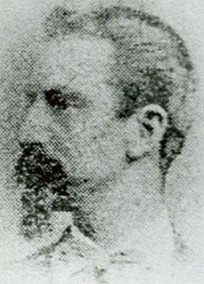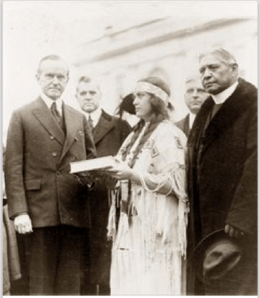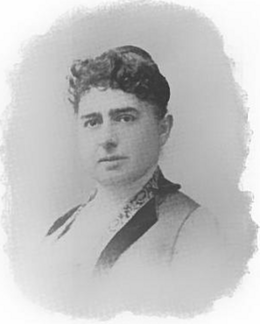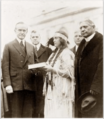Sherman Coolidge facts for kids
Quick facts for kids Sherman Coolidge |
|
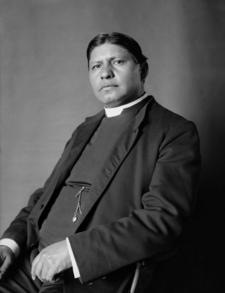 Sherman Coolidge was a founder and leader of the Society of American Indians (1911-1923), the first national American Indian rights organization run by and for American Indians |
|
| Born | February 22, 1862 in Near present-day Sheridan, Wyoming |
|---|---|
| Died | January 24, 1932 (aged 69) in Los Angeles, California |
| Church | Episcopal Church |
| Education | Seabury Divinity School Hobart College |
| Ordained | 1884 |
| Spouse | Grace Wetherbee Coolidge |
Sherman Coolidge (February 22, 1862 – January 24, 1932) was an Episcopal Church priest and teacher. He helped start and lead the Society of American Indians (1911–1923). This group was the first national organization for American Indian rights. It was run by and for Native Americans. The Society helped create the idea of Pan-Indianism. This is a movement that brings together American Indians from different tribes.
Coolidge worked for 26 years teaching and preaching to the Shoshone and Arapaho people. This was at the Wind River Indian Reservation in Fort Washakie, Wyoming. He traveled across the United States, giving talks to support Native Americans. In 1923, he joined President Calvin Coolidge's "Committee of One Hundred." This group advised on American Indian policy. Later, in the 1920s, Coolidge moved to Colorado. He became a Canon at the Cathedral of St. John in the Wilderness in Denver, Colorado and also served in Colorado Springs, Colorado.
Contents
Sherman Coolidge's Early Life
Sherman Coolidge was born on February 22, 1862. His birthplace was near what is now Sheridan, Wyoming. His family camped near the Bighorn River. His parents, Banasda (Big Heart) and Ba-ahnoce (Turtle Woman), were both Arapaho. They named their new son Doa-che-wa-a, which means "Runs-on-Top." His family moved with the seasons to hunt and gather food. They often competed with the Eastern Shoshone for resources.
When Sherman was a young boy, his camp faced dangers. Shoshone warriors sometimes attacked. His family also faced sad events involving soldiers. Once, soldiers mistook his Arapaho family for another tribe. This led to the deaths of his aunt, uncle, and grandmother.
In the spring of 1867, another tragedy happened. While camped by a stream, his family was woken by war cries. His father, Banasda, bravely stayed to fight the attackers. He was shot and killed while his family ran to safety.
As pioneers traveled through Wyoming on trails like the Oregon Trail, there was more conflict. This was between the military and Native American tribes like the Arapaho and Lakota. The Treaty of Fort Laramie (1868) created the Great Sioux Reservation. The Northern Arapaho, without their own land, joined the Lakota or Southern Arapaho.
In 1870, Sherman Coolidge was with a group of Arapaho. They were camped near Camp Brown (now Lander, Wyoming). Most of the men were away hunting. A group attacked the Arapaho camp. They were helped by the Shoshone and Bannocks. Sherman was captured during this attack. He saw difficult things. He was then taken to Camp Brown. There, the camp doctor, Dr. Shapleigh, and two army officers cared for him. His two younger brothers were also taken in by army officers.
Adoption and Education
Dr. Shapleigh became Sherman's guardian. The boys were sad to be separated from their mother. He-Runs-on-Top was given a new name: William Tecumseh Sherman. This was after a famous Union Army general. Later, Lieutenant Charles A. Coolidge and his wife, Sofie, adopted "Sherman." They took him to New York City. There, he went to a school for African American children. He was baptized at Grace Episcopal Church. His adoptive parents treated him like their own son. They taught him about their religion and love for their country.
The Coolidges lived in New York until 1873. Then, Charles Coolidge was sent to the Montana Territory. They lived at Fort Shaw. Sherman went to school there.
In 1876, Lieutenant Colonel George Armstrong Custer was killed. This happened during the Battle of the Little Bighorn against the Lakota. Charles Coolidge's army unit buried the dead. His adoptive father wanted Sherman to have a military career. He took him on trips against the Lakota. But these experiences during the Great Sioux War of 1876 made Sherman decide he did not want to be a soldier.
From 1877 to 1880, he studied at Shattuck-Saint Mary's. This was an Episcopalian school in Faribault, Minnesota. Following advice from Henry Benjamin Whipple, he then went to the Seabury Divinity School. He earned a Bachelor of Divinity degree in 1884. Bishop Whipple made him a deacon that same year. On May 25, 1885, Bishop John Franklin Spalding made him a priest.
He also did more studies at Hobart College in Geneva, New York. This was between 1887 and 1890.
Career and Contributions
Missionary Work in Wyoming

After finishing divinity school, Coolidge traveled west to Wyoming. He was called "Arapaho Whiteman." In the fall of 1884, he reunited with his mother, Ba-ahnoce, at the Wind River Indian Reservation. She had heard he was coming back. For 15 years, his people had struggled to find a home. They also worked hard to keep their culture alive. The Bureau of Indian Affairs had strict control over them. The Northern Arapaho needed to make peace with the Eastern Shoshone to survive. When Coolidge arrived, his mother and other relatives, including his uncle Chief Sharp Nose, met him.
The Episcopal Church was in charge of eight Indian agencies. One of these was the Wind River Indian Agency in Wyoming. On October 2, 1884, Deacon Coolidge began helping Episcopalian priest John Roberts. They worked at the St. Michael's Mission and government school for the Shoshones.
After becoming a priest in 1885, Rev. Coolidge went to the Wind River Reservation. Shoshones and Arapahos tried to live together there. Besides being a priest, he was also a mediator, government clerk, and school teacher. This was the start of his 26-year career in Wyoming. He and his wife, Grace, worked together. They had new ideas and worked hard to teach Christianity.
To survive the westward expansion, the Arapaho had to change their way of life. They could no longer hunt and gather freely. The U.S. government wanted them to farm. But the soil on the reservation was poor. They were given food rations to prevent starvation. If they did not follow government rules, they could lose their rations or even be imprisoned. Arapaho and Shoshone children went to schools on the reservation.
Work with the Society of American Indians
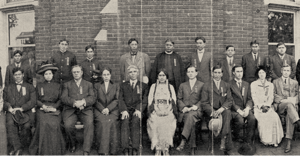
Coolidge and Dr. Charles Eastman helped create and lead the Society of American Indians (1911-1923). This was the first national organization for American Indian rights. It was run by and for Native Americans. Coolidge was involved with the Society longer than any other leader. The Society helped start the idea of Pan-Indianism. This is a movement that promotes unity among all American Indians.
Coolidge believed that Native Americans needed to "stand solid and united." He wanted them to stop tribal rivalries. He once said that people thought he was smart because he was Arapaho. But he believed many other tribes were just as smart. He wanted everyone to work together.
The Society was a place for new American Indian leaders. These leaders, called Red Progressives, believed in progress through education and government action. They included clergy, activists, writers, and speakers.
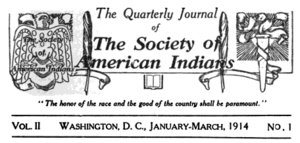
The Society held meetings at universities. They had an office in Washington, D.C. They also published a journal with writings by American Indian authors. They were among the first to suggest an "American Indian Day." They also fought for Native American citizenship. They wanted all tribes to be able to use the United States Court of Federal Claims. This Society helped bring about important changes for Native Americans decades later. These changes included school system reforms and new laws.
In 1915, Coolidge called for the second Saturday of May to be known as "American Indian Day."
Committee of One Hundred

In 1923, Secretary of Interior Herbert W. Work asked Coolidge to join the Committee of One Hundred. This group was formed to "investigate conditions on reservations." They also reported on the challenges faced by Native peoples in the United States. Reverend Coolidge met with President Calvin Coolidge in December of that year.
In May 1923, Coolidge and other Society leaders helped start the American Indian Defense Association. This was a new group that worked to influence policy in Washington.
In response, the Secretary of the Interior, Hubert Work, created the "Advisory Council on Indian Affairs." This became known as the "Committee of One Hundred." It included many important people. Their suggestions led to a big study of the conditions of Native Americans. This study was called the Meriam Report.
In December 1923, Rev. Coolidge and Ruth Muskrat-Bronson gave President Calvin Coolidge a book. It was about Native Americans in the United States. The Meriam Report was published in 1928. It led to big changes in American Indian policy. It helped set the stage for the Indian Reorganization Act, also known as the Indian New Deal.
Marriage and Family Life
Sherman met Grace D. Wetherbee in 1899. She was from a wealthy family in New York City. He was working as a missionary on an Arapaho reservation in Wyoming. Grace had studied in New York City. She came west to help with missionary work at the Wind River Reservation. Coolidge visited New York, and Grace came west again in 1901. Grace left a comfortable life. Her father owned the Hotel Manhattan, which was then the tallest hotel in the world.
Sherman and Grace married on October 8, 1902, in Fort Washakie, Wyoming. Their marriage caused a stir. Newspapers had headlines like "Society Girl's Heart and Hand Captured by an Indian." This showed how unusual it was for a white woman to marry a Native American at that time.
The Coolidges adopted two Native American girls. One was Shoshone, and the other was Arapaho. Both were born in Wyoming. The girls, Effie and Virgie, studied at the Carlisle Indian Industrial School. They also had two other children, Sarah and Sophia.
Grace Wetherbee Coolidge wrote a lot about her experiences. Her stories about life on the Wind River Reservation were published in magazines. In 1917, her collection of stories, "Teepee Neighbors," was published as a book.
Later Life and Legacy
Sherman Coolidge died on January 24, 1932, while visiting Los Angeles. He was buried at Evergreen Cemetery (Colorado Springs, Colorado) in Colorado Springs. His wife, Grace, died five years later and was buried next to him. She left money to the Wind River mission.
Coolidge was considered for Wyoming Citizen of the Century. This honor is for people who showed great character and made important contributions. He was a strong supporter of Native American interests. He helped start two important movements that brought Native Americans together.
Images for kids
-
Sherman Coolidge was a founder and leader of the Society of American Indians (1911-1923), the first national American Indian rights organization run by and for American Indians
-
Shoshone Indians at Fort Washakie, Wyoming. Some of the Shoshones are dancing as the soldiers look on. This is the last photograph of Chief Washakie, who is on the extreme left, standing and pointing.
-
Rev. Coolidge at Wind River School, Fort Washakie, Wyoming
-
First conference of the Society of American Indians, Ohio State University, Columbus, Ohio, 1911. Coolidge center.
-
The Society of American Indians was the first national American Indian rights organization run by and for American Indians. Arthur C. Parker was the editor-general. Coolidge, John M. Oskison, Carlos Montezuma, Howard Gansworth, and Henry Roe Cloud were contributing editors.
-
President Calvin Coolidge presented with a book written by G. E. E. Linquist titled "The Red Man In The United States" (1919). Ruth Muskrat Bronson (center) making the presentation on behalf of the "Committee of One Hundred" with Coolidge (right), December, 1923.
-
Coolidge served as a canon at the Cathedral of St. John in the Wilderness in Denver, Colorado.
See also
 In Spanish: Sherman Coolidge para niños
In Spanish: Sherman Coolidge para niños



